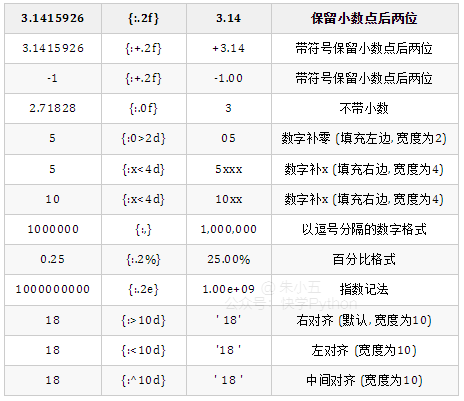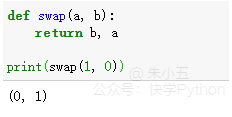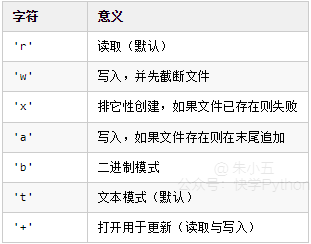整理了60个 Python 小例子,拿来即用!

作者 | 快学Python
来源 | https://github.com/jackzhenguo/python-small-examples
今天给大家分享一下60个Python小例子,拿来即用!
一、 数字
1、求绝对值
绝对值或复数的模
#?公众号:快学Python
In?[1]:?abs(-6)??
Out[1]:?6
2 进制转化
十进制转换为二进制:
In?[2]:?bin(10)??
Out[2]:?'0b1010'
十进制转换为八进制:
In?[3]:?oct(9)??
Out[3]:?'0o11'
十进制转换为十六进制:
In?[4]:?hex(15)??
Out[4]:?'0xf'
3 整数和ASCII互转
十进制整数对应的ASCII字符
In?[1]:?chr(65)??
Out[1]:?'A'
查看某个ASCII字符对应的十进制数
In?[1]:?ord('A')??
Out[1]:?65
4 元素都为真检查
所有元素都为真,返回?True,否则为False
In?[5]:?all([1,0,3,6])??
Out[5]:?False
In?[6]:?all([1,2,3])??
Out[6]:?True
5 元素至少一个为真检查
至少有一个元素为真返回True,否则False
In?[7]:?any([0,0,0,[]])??
Out[7]:?False
In?[8]:?any([0,0,1])??
Out[8]:?True
6 判断是真是假
测试一个对象是True, 还是False.
In?[9]:?bool([0,0,0])??
Out[9]:?True??
??
In?[10]:?bool([])??
Out[10]:?False??
??
In?[11]:?bool([1,0,1])??
Out[11]:?True
7 创建复数
创建一个复数
In?[1]:?complex(1,2)??
Out[1]:?(1+2j)
8 取商和余数
分别取商和余数
In?[1]:?divmod(10,3)??
Out[1]:?(3,?1)
9 转为浮点类型
将一个整数或数值型字符串转换为浮点数
In?[1]:?float(3)??
Out[1]:?3.0
如果不能转化为浮点数,则会报ValueError:
In?[2]:?float('a')??
#?ValueError:?could?not?convert?string?to?float:?'a'
10 转为整型
int(x, base =10) , x可能为字符串或数值,将x 转换为一个普通整数。如果参数是字符串,那么它可能包含符号和小数点。如果超出了普通整数的表示范围,一个长整数被返回。
In?[1]:?int('12',16)??
Out[1]:?18
11 次幂
base为底的exp次幂,如果mod给出,取余
In?[1]:?pow(3,?2,?4)??
Out[1]:?1
12 四舍五入
四舍五入,ndigits代表小数点后保留几位:
In?[11]:?round(10.0222222,?3)??
Out[11]:?10.022??
??
In?[12]:?round(10.05,1)??
Out[12]:?10.1
13 链式比较
i?=?3??
print(1?<?i?<?3)??#?False??
print(1?<?i?<=?3)??#?True
二、 字符串
14 字符串转字节
字符串转换为字节类型
In?[12]:?s?=?"apple"??????????????????????????????????????????????????????????????
??
In?[13]:?bytes(s,encoding='utf-8')??
Out[13]:?b'apple'
15 任意对象转为字符串
In?[14]:?i?=?100??????????????????????????????????????????????????????????????????
??
In?[15]:?str(i)??
Out[15]:?'100'??
??
In?[16]:?str([])??
Out[16]:?'[]'??
??
In?[17]:?str(tuple())??
Out[17]:?'()'
16 执行字符串表示的代码
将字符串编译成python能识别或可执行的代码,也可以将文字读成字符串再编译。
In?[1]:?s??=?"print('helloworld')"??
??????
In?[2]:?r?=?compile(s,"<string>",?"exec")??
??????
In?[3]:?r??
Out[3]:?<code?object?<module>?at?0x0000000005DE75D0,?file?"<string>",?line?1>??
??????
In?[4]:?exec(r)??
helloworld
17 计算表达式
将字符串str 当成有效的表达式来求值并返回计算结果取出字符串中内容
In?[1]:?s?=?"1?+?3?+5"??
????...:?eval(s)??
????...:??
Out[1]:?9
18 字符串格式化
格式化输出字符串,format(value, format_spec)实质上是调用了value的__format__(format_spec)方法。
In?[1]:?print("i?am?{0},age{1}".format("tom",18))??
Out[1]:i?am?tom,age18??

三、 函数
19 拿来就用的排序函数
排序:
In?[1]:?a?=?[1,4,2,3,1]??
??
In?[2]:?sorted(a,reverse=True)??
Out[2]:?[4,?3,?2,?1,?1]??
??
In?[3]:?a?=?[{'name':'xiaoming','age':18,'gender':'male'},{'name':'??
?????...:?xiaohong','age':20,'gender':'female'}]??
In?[4]:?sorted(a,key=lambda?x:?x['age'],reverse=False)??
Out[4]:??
[{'name':?'xiaoming',?'age':?18,?'gender':?'male'},??
?{'name':?'xiaohong',?'age':?20,?'gender':?'female'}]
20 求和函数
求和:
In?[181]:?a?=?[1,4,2,3,1]??
??
In?[182]:?sum(a)??
Out[182]:?11??
#?公众号:快学Python
In?[185]:?sum(a,10)?#求和的初始值为10??
Out[185]:?21
21 nonlocal用于内嵌函数中
关键词nonlocal常用于函数嵌套中,声明变量i为非局部变量;如果不声明,i+=1表明i为函数wrapper内的局部变量,因为在i+=1引用(reference)时,i未被声明,所以会报unreferenced variable的错误。
def?excepter(f):??
????i?=?0??
????t1?=?time.time()??
????def?wrapper():??
????????try:??
????????????f()??
????????except?Exception?as?e:??
????????????nonlocal?i??
????????????i?+=?1??
????????????print(f'{e.args[0]}:?{i}')??
????????????t2?=?time.time()??
????????????if?i?==?n:??
????????????????print(f'spending?time:{round(t2-t1,2)}')??
????return?wrapper
22 global 声明全局变量
先回答为什么要有global,一个变量被多个函数引用,想让全局变量被所有函数共享。有的伙伴可能会想这还不简单,这样写:
i?=?5??
def?f():??
????print(i)??
??
def?g():??
????print(i)??
????pass??
??
f()??
g()
f和g两个函数都能共享变量i,程序没有报错,所以他们依然不明白为什么要用global.
但是,如果我想要有个函数对i递增,这样:
def?h():??
????i?+=?1??
??
h()
此时执行程序,bang, 出错了!抛出异常:UnboundLocalError,原来编译器在解释i+=1时会把i解析为函数h()内的局部变量,很显然在此函数内,编译器找不到对变量i的定义,所以会报错。
global就是为解决此问题而被提出,在函数h内,显式地告诉编译器i为全局变量,然后编译器会在函数外面寻找i的定义,执行完i+=1后,i还为全局变量,值加1:
i?=?0??
def?h():??
????global?i??
????i?+=?1??
??
h()??
print(i)
23 交换两元素
def?swap(a,?b):??
????return?b,?a??
print(swap(1,?0))
输出:

24 操作函数对象
In?[31]:?def?f():??
????...:?????print('i'm?f')??
????...:??
??
In?[32]:?def?g():??
????...:?????print('i'm?g')??
????...:??
??
In?[33]:?[f,g][1]()??
i'm?g
创建函数对象的list,根据想要调用的index,方便统一调用。
25 生成逆序序列
list(range(10,-1,-1))?#?[10,?9,?8,?7,?6,?5,?4,?3,?2,?1,?0]
第三个参数为负时,表示从第一个参数开始递减,终止到第二个参数(不包括此边界)
26 函数的五类参数使用例子
python五类参数:位置参数,关键字参数,默认参数,可变位置或关键字参数的使用。
def?f(a,*b,c=10,**d):??
??print(f'a:{a},b:{b},c:{c},d:{d}')
默认参数c不能位于可变关键字参数d后.
调用f:
In?[10]:?f(1,2,5,width=10,height=20)??
a:1,b:(2,?5),c:10,d:{'width':?10,?'height':?20}
可变位置参数b实参后被解析为元组(2,5);而c取得默认值10; d被解析为字典.
再次调用f:
In?[11]:?f(a=1,c=12)??
a:1,b:(),c:12,d:{}
a=1传入时a就是关键字参数,b,d都未传值,c被传入12,而非默认值。
注意观察参数a, 既可以f(1),也可以f(a=1)?其可读性比第一种更好,建议使用f(a=1)。如果要强制使用f(a=1),需要在前面添加一个星号:
def?f(*,a,**b):?
????print(f'a:{a},b:{b}')
此时f(1)调用,将会报错:TypeError: f() takes 0 positional arguments but 1 was given
只能f(a=1)才能OK.
说明前面的*发挥作用,它变为只能传入关键字参数,那么如何查看这个参数的类型呢?借助python的inspect模块:
In?[22]:?for?name,val?in?signature(f).parameters.items():??
????...:?????print(name,val.kind)??
????...:??
a?KEYWORD_ONLY??
b?VAR_KEYWORD
可看到参数a的类型为KEYWORD_ONLY,也就是仅仅为关键字参数。
但是,如果f定义为:
def?f(a,*b):??
????print(f'a:{a},b:{b}')
查看参数类型:
In?[24]:?for?name,val?in?signature(f).parameters.items():??
????...:?????print(name,val.kind)??
????...:??
a?POSITIONAL_OR_KEYWORD??
b?VAR_POSITIONAL
可以看到参数a既可以是位置参数也可是关键字参数。
27 使用slice对象
生成关于蛋糕的序列cake1:
In?[1]:?cake1?=?list(range(5,0,-1))??
??
In?[2]:?b?=?cake1[1:10:2]??
??
In?[3]:?b??
Out[3]:?[4,?2]??
??
In?[4]:?cake1??
Out[4]:?[5,?4,?3,?2,?1]
再生成一个序列:
In?[5]:?from?random?import?randint??
???...:?cake2?=?[randint(1,100)?for?_?in?range(100)]??
???...:?#?同样以间隔为2切前10个元素,得到切片d??
???...:?d?=?cake2[1:10:2]??
In?[6]:?d??
Out[6]:?[75,?33,?63,?93,?15]
你看,我们使用同一种切法,分别切开两个蛋糕cake1,cake2. 后来发现这种切法极为经典,又拿它去切更多的容器对象。
那么,为什么不把这种切法封装为一个对象呢?于是就有了slice对象。
定义slice对象极为简单,如把上面的切法定义成slice对象:
perfect_cake_slice_way?=?slice(1,10,2)??
#去切cake1??
cake1_slice?=?cake1[perfect_cake_slice_way]??
cake2_slice?=?cake2[perfect_cake_slice_way]??
??
In?[11]:?cake1_slice??
Out[11]:?[4,?2]??
??
In?[12]:?cake2_slice??
Out[12]:?[75,?33,?63,?93,?15]
与上面的结果一致。
对于逆向序列切片,slice对象一样可行:
a?=?[1,3,5,7,9,0,3,5,7]??
a_?=?a[5:1:-1]??
??
named_slice?=?slice(5,1,-1)??
a_slice?=?a[named_slice]??
??
In?[14]:?a_??
Out[14]:?[0,?9,?7,?5]??
??
In?[15]:?a_slice??
Out[15]:?[0,?9,?7,?5]
频繁使用同一切片的操作可使用slice对象抽出来,复用的同时还能提高代码可读性。
28 lambda 函数的动画演示
有些读者反映,lambda函数不太会用,问我能不能解释一下。
比如,下面求这个?lambda函数:
def?max_len(*lists):??
????return?max(*lists,?key=lambda?v:?len(v))
有两点疑惑:
参数
v的取值?lambda函数有返回值吗?如果有,返回值是多少?
调用上面函数,求出以下三个最长的列表:
r?=?max_len([1,?2,?3],?[4,?5,?6,?7],?[8])??
print(f'更长的列表是{r}')
程序完整运行过程,动画演示如下:

结论:
参数v的可能取值为
*lists,也就是?tuple?的一个元素。lambda函数返回值,等于lambda v冒号后表达式的返回值。
四、 数据结构
29 转为字典
创建数据字典
In?[1]:?dict()??
Out[1]:?{}??
??
In?[2]:?dict(a='a',b='b')??
Out[2]:?{'a':?'a',?'b':?'b'}??
??
In?[3]:?dict(zip(['a','b'],[1,2]))??
Out[3]:?{'a':?1,?'b':?2}??
??
In?[4]:?dict([('a',1),('b',2)])??
Out[4]:?{'a':?1,?'b':?2}
30 冻结集合
创建一个不可修改的集合。
In?[1]:?frozenset([1,1,3,2,3])??
Out[1]:?frozenset({1,?2,?3})
因为不可修改,所以没有像set那样的add和pop方法
31 转为集合类型
返回一个set对象,集合内不允许有重复元素:
In?[159]:?a?=?[1,4,2,3,1]??
??
In?[160]:?set(a)??
Out[160]:?{1,?2,?3,?4}
32 转为切片对象
class?slice(start,?stop[,?step])
返回一个表示由 range(start, stop, step) 所指定索引集的 slice对象,它让代码可读性、可维护性变好。
In?[1]:?a?=?[1,4,2,3,1]??
??
In?[2]:?my_slice_meaning?=?slice(0,5,2)??
??
In?[3]:?a[my_slice_meaning]??
Out[3]:?[1,?2,?1]
33 转元组
tuple()?将对象转为一个不可变的序列类型
In?[16]:?i_am_list?=?[1,3,5]??
In?[17]:?i_am_tuple?=?tuple(i_am_list)??
In?[18]:?i_am_tuple??
Out[18]:?(1,?3,?5)
五、 类和对象
34 是否可调用
检查对象是否可被调用
In?[1]:?callable(str)??
Out[1]:?True??
??
In?[2]:?callable(int)??
Out[2]:?True
In?[18]:?class?Student():??
????...:?????def?__init__(self,id,name):??
????...:?????????self.id?=?id???
????...:?????????self.name?=?name???
????...:?????def?__repr__(self):??
????...:?????????return?'id?=?'+self.id?+',?name?=?'+self.name???
????...??
??
In?[19]:?xiaoming?=?Student('001','xiaoming')??
??
In?[20]:?callable(xiaoming)??
Out[20]:?False
如果能调用xiaoming(), 需要重写Student类的__call__方法:
In?[1]:?class?Student():??
????...:?????def?__init__(self,id,name):??
????...:?????????self.id?=?id??
????...:?????????self.name?=?name??
????...:?????def?__repr__(self):??
????...:?????????return?'id?=?'+self.id?+',?name?=?'+self.name??
????...:?????def?__call__(self):??
????...:?????????print('I?can?be?called')??
????...:?????????print(f'my?name?is?{self.name}')??
????...:??
??
In?[2]:?t?=?Student('001','xiaoming')??
??
In?[3]:?t()??
I?can?be?called??
my?name?is?xiaoming
35 ascii 展示对象
调用对象的?__repr__?方法,获得该方法的返回值,如下例子返回值为字符串
>>>?class?Student():??
????def?__init__(self,id,name):??
????????self.id?=?id??
????????self.name?=?name??
????def?__repr__(self):??
????????return?'id?=?'+self.id?+',?name?=?'+self.name
调用:
>>>?xiaoming?=?Student(id='1',name='xiaoming')??
>>>?xiaoming??
id?=?1,?name?=?xiaoming??
>>>?ascii(xiaoming)??
'id?=?1,?name?=?xiaoming'
36 类方法
classmethod?装饰器对应的函数不需要实例化,不需要?self?参数,但第一个参数需要是表示自身类的 cls 参数,可以来调用类的属性,类的方法,实例化对象等。
In?[1]:?class?Student():??
????...:?????def?__init__(self,id,name):??
????...:?????????self.id?=?id??
????...:?????????self.name?=?name??
????...:?????def?__repr__(self):??
????...:?????????return?'id?=?'+self.id?+',?name?=?'+self.name??
????...:?????@classmethod??
????...:?????def?f(cls):??
????...:?????????print(cls)
37 动态删除属性
删除对象的属性
In?[1]:?delattr(xiaoming,'id')??
??
In?[2]:?hasattr(xiaoming,'id')??
Out[2]:?False
38 一键查看对象所有方法
不带参数时返回当前范围内的变量、方法和定义的类型列表;带参数时返回参数的属性,方法列表。
In?[96]:?dir(xiaoming)??
Out[96]:??
['__class__',??
?'__delattr__',??
?'__dict__',??
?'__dir__',??
?'__doc__',??
?'__eq__',??
?'__format__',??
?'__ge__',??
?'__getattribute__',??
?'__gt__',??
?'__hash__',??
?'__init__',??
?'__init_subclass__',??
?'__le__',??
?'__lt__',??
?'__module__',??
?'__ne__',??
?'__new__',??
?'__reduce__',??
?'__reduce_ex__',??
?'__repr__',??
?'__setattr__',??
?'__sizeof__',??
?'__str__',??
?'__subclasshook__',??
?'__weakref__',??
???
?'name']
39 动态获取对象属性
获取对象的属性
In?[1]:?class?Student():??
???...:?????def?__init__(self,id,name):??
???...:?????????self.id?=?id??
???...:?????????self.name?=?name??
???...:?????def?__repr__(self):??
???...:?????????return?'id?=?'+self.id?+',?name?=?'+self.name??
??
In?[2]:?xiaoming?=?Student(id='001',name='xiaoming')??
In?[3]:?getattr(xiaoming,'name')?#?获取xiaoming这个实例的name属性值??
Out[3]:?'xiaoming'
40 对象是否有这个属性
In?[1]:?class?Student():??
???...:?????def?__init__(self,id,name):??
???...:?????????self.id?=?id??
???...:?????????self.name?=?name??
???...:?????def?__repr__(self):??
???...:?????????return?'id?=?'+self.id?+',?name?=?'+self.name??
??
In?[2]:?xiaoming?=?Student(id='001',name='xiaoming')??
In?[3]:?hasattr(xiaoming,'name')??
Out[3]:?True??
??
In?[4]:?hasattr(xiaoming,'address')??
Out[4]:?False
41 对象门牌号
返回对象的内存地址
In?[1]:?id(xiaoming)??
Out[1]:?98234208
42 isinstance
判断_object_是否为类_classinfo_的实例,是返回true
In?[1]:?class?Student():??
???...:?????def?__init__(self,id,name):??
???...:?????????self.id?=?id??
???...:?????????self.name?=?name??
???...:?????def?__repr__(self):??
???...:?????????return?'id?=?'+self.id?+',?name?=?'+self.name??
??
In?[2]:?xiaoming?=?Student(id='001',name='xiaoming')??
??
In?[3]:?isinstance(xiaoming,Student)??
Out[3]:?True
43 父子关系鉴定
In?[1]:?class?undergraduate(Student):??
????...:?????def?studyClass(self):??
????...:?????????pass??
????...:?????def?attendActivity(self):??
????...:?????????pass??
??
In?[2]:?issubclass(undergraduate,Student)??
Out[2]:?True??
??
In?[3]:?issubclass(object,Student)??
Out[3]:?False??
??
In?[4]:?issubclass(Student,object)??
Out[4]:?True
如果class是classinfo元组中某个元素的子类,也会返回True
In?[1]:?issubclass(int,(int,float))??
Out[1]:?True
44 所有对象之根
object 是所有类的基类
In?[1]:?o?=?object()??
??
In?[2]:?type(o)??
Out[2]:?object
45 创建属性的两种方式
返回 property 属性,典型的用法:
class?C:??
????def?__init__(self):??
????????self._x?=?None??
??
????def?getx(self):??
????????return?self._x??
??
????def?setx(self,?value):??
????????self._x?=?value??
??
????def?delx(self):??
????????del?self._x??
????#?使用property类创建?property?属性??
????x?=?property(getx,?setx,?delx,?"I'm?the?'x'?property.")
使用python装饰器,实现与上完全一样的效果代码:
class?C:??
????def?__init__(self):??
????????self._x?=?None??
??
????@property??
????def?x(self):??
????????return?self._x??
??
????@x.setter??
????def?x(self,?value):??
????????self._x?=?value??
??
????@x.deleter??
????def?x(self):??
????????del?self._x
46 查看对象类型
class?type(name,?bases,?dict)
传入一个参数时,返回?object?的类型:
In?[1]:?class?Student():??
???...:?????def?__init__(self,id,name):??
???...:?????????self.id?=?id??
???...:?????????self.name?=?name??
???...:?????def?__repr__(self):??
???...:?????????return?'id?=?'+self.id?+',?name?=?'+self.name??
???...:??
??
In?[2]:?xiaoming?=?Student(id='001',name='xiaoming')??
In?[3]:?type(xiaoming)??
Out[3]:?__main__.Student??
??
In?[4]:?type(tuple())??
Out[4]:?tuple
47 元类
xiaoming,?xiaohong,?xiaozhang?都是学生,这类群体叫做?Student.
Python 定义类的常见方法,使用关键字?class
In?[36]:?class?Student(object):??
????...:?????pass
xiaoming,?xiaohong,?xiaozhang?是类的实例,则:
xiaoming?=?Student()??
xiaohong?=?Student()??
xiaozhang?=?Student()
创建后,xiaoming 的?__class__?属性,返回的便是?Student类
In?[38]:?xiaoming.__class__??
Out[38]:?__main__.Student
问题在于,Student?类有?__class__属性,如果有,返回的又是什么?
In?[39]:?xiaoming.__class__.__class__??
Out[39]:?type
哇,程序没报错,返回?type
那么,我们不妨猜测:Student?类,类型就是?type
换句话说,Student类就是一个对象,它的类型就是?type
所以,Python 中一切皆对象,类也是对象
Python 中,将描述?Student?类的类被称为:元类。
按照此逻辑延伸,描述元类的类被称为:_元元类_,开玩笑了~ 描述元类的类也被称为元类。
聪明的朋友会问了,既然?Student?类可创建实例,那么?type?类可创建实例吗?如果能,它创建的实例就叫:类 了。你们真聪明!
说对了,type?类一定能创建实例,比如?Student?类了。
In?[40]:?Student?=?type('Student',(),{})??
??
In?[41]:?Student??
Out[41]:?__main__.Student
它与使用?class?关键字创建的?Student?类一模一样。
Python 的类,因为又是对象,所以和?xiaoming,xiaohong?对象操作相似。支持:
赋值
拷贝
添加属性
作为函数参数
In?[43]:?StudentMirror?=?Student?#?类直接赋值?#?类直接赋值??
In?[44]:?Student.class_property?=?'class_property'?#?添加类属性??
In?[46]:?hasattr(Student,?'class_property')??
Out[46]:?True
元类,确实使用不是那么多,也许先了解这些,就能应付一些场合。就连 Python 界的领袖?Tim Peters?都说:
“元类就是深度的魔法,99%的用户应该根本不必为此操心。
六、工具
48 枚举对象
返回一个可以枚举的对象,该对象的next()方法将返回一个元组。
In?[1]:?s?=?["a","b","c"]??
????...:?for?i?,v?in?enumerate(s,1):??
????...:?????print(i,v)??
????...:??
1?a??
2?b??
3?c
49 查看变量所占字节数
In?[1]:?import?sys??
??
In?[2]:?a?=?{'a':1,'b':2.0}??
??
In?[3]:?sys.getsizeof(a)?#?占用240个字节??
Out[3]:?240
50 过滤器
在函数中设定过滤条件,迭代元素,保留返回值为True的元素:
In?[1]:?fil?=?filter(lambda?x:?x>10,[1,11,2,45,7,6,13])??
??
In?[2]:?list(fil)??
Out[2]:?[11,?45,?13]
51 返回对象的哈希值
返回对象的哈希值,值得注意的是自定义的实例都是可哈希的,list,?dict,?set等可变对象都是不可哈希的(unhashable)
In?[1]:?hash(xiaoming)??
Out[1]:?6139638??
??
In?[2]:?hash([1,2,3])??
#?TypeError:?unhashable?type:?'list'
52 一键帮助
返回对象的帮助文档
In?[1]:?help(xiaoming)??
Help?on?Student?in?module?__main__?object:??
??
class?Student(builtins.object)??
?|??Methods?defined?here:??
?|??
?|??__init__(self,?id,?name)??
?|??
?|??__repr__(self)??
?|??
?|??Data?descriptors?defined?here:??
?|??
?|??__dict__??
?|??????dictionary?for?instance?variables?(if?defined)??
?|??
?|??__weakref__??
?|??????list?of?weak?references?to?the?object?(if?defined)
53? 获取用户输入
获取用户输入内容
In?[1]:?input()??
aa??
Out[1]:?'aa'
54 创建迭代器类型
使用iter(obj, sentinel), 返回一个可迭代对象, sentinel可省略(一旦迭代到此元素,立即终止)
In?[1]:?lst?=?[1,3,5]??
??
In?[2]:?for?i?in?iter(lst):??
????...:?????print(i)??
????...:??
1??
3??
5
In?[1]:?class?TestIter(object):??
????...:?????def?__init__(self):??
????...:?????????self.l=[1,3,2,3,4,5]??
????...:?????????self.i=iter(self.l)??
????...:?????def?__call__(self):??#定义了__call__方法的类的实例是可调用的??
????...:?????????item?=?next(self.i)??
????...:?????????print?("__call__?is?called,fowhich?would?return",item)??
????...:?????????return?item??
????...:?????def?__iter__(self):?#支持迭代协议(即定义有__iter__()函数)??
????...:?????????print?("__iter__?is?called!!")??
????...:?????????return?iter(self.l)??
In?[2]:?t?=?TestIter()??
In?[3]:?t()?#?因为实现了__call__,所以t实例能被调用??
__call__?is?called,which?would?return?1??
Out[3]:?1??
??
In?[4]:?for?e?in?TestIter():?#?因为实现了__iter__方法,所以t能被迭代??
????...:?????print(e)??
????...:??
__iter__?is?called!!??
1??
3??
2??
3??
4??
5
55 打开文件
返回文件对象
In?[1]:?fo?=?open('D:/a.txt',mode='r',?encoding='utf-8')??
??
In?[2]:?fo.read()??
Out[2]:?'\ufefflife?is?not?so?long,\nI?use?Python?to?play.'
mode取值表:

56 创建range序列
range(stop) range(start, stop[,step])
In?[1]:?range(11)??
Out[1]:?range(0,?11)??
??
In?[2]:?range(0,11,1)??
Out[2]:?range(0,?11)
57 反向迭代器
In?[1]:?rev?=?reversed([1,4,2,3,1])??
??
In?[2]:?for?i?in?rev:??
?????...:?????print(i)??
?????...:??
1??
3??
2??
4??
1
58 聚合迭代器
In?[1]:?x?=?[3,2,1]??
In?[2]:?y?=?[4,5,6]??
In?[3]:?list(zip(y,x))??
Out[3]:?[(4,?3),?(5,?2),?(6,?1)]??
??
In?[4]:?a?=?range(5)??
In?[5]:?b?=?list('abcde')??
In?[6]:?b??
Out[6]:?['a',?'b',?'c',?'d',?'e']??
In?[7]:?[str(y)?+?str(x)?for?x,y?in?zip(a,b)]??
Out[7]:?['a0',?'b1',?'c2',?'d3',?'e4']
59 链式操作
from?operator?import?(add,?sub)??
??
??
def?add_or_sub(a,?b,?oper):??
????return?(add?if?oper?==?'+'?else?sub)(a,?b)??
??
??
add_or_sub(1,?2,?'-')??#?-1
60 对象序列化
class?Student():??
????def?__init__(self,**args):??
????????self.ids?=?args['ids']??
????????self.name?=?args['name']??
????????self.address?=?args['address']??
xiaoming?=?Student(ids?=?1,name?=?'xiaoming',address?=?'北京')??
xiaohong?=?Student(ids?=?2,name?=?'xiaohong',address?=?'南京')
import?json??
??
with?open('json.txt',?'w')?as?f:??
????json.dump([xiaoming,xiaohong],?f,?default=lambda?obj:?obj.__dict__,?ensure_ascii=False,?indent=2,?sort_keys=True)
[??
????{??
????????"address":"北京",??
????????"ids":1,??
????????"name":"xiaoming"??
????},??
????{??
????????"address":"南京",??
????????"ids":2,??
????????"name":"xiaohong"??
????}??
]


分享
点收藏
点点赞
点在看
关注公众号:拾黑(shiheibook)了解更多
[广告]赞助链接:
四季很好,只要有你,文娱排行榜:https://www.yaopaiming.com/
让资讯触达的更精准有趣:https://www.0xu.cn/
 关注网络尖刀微信公众号
关注网络尖刀微信公众号随时掌握互联网精彩
- 1 中国经济向世界提供“机遇清单” 7904095
- 2 朱元璋换帅照后明孝陵火了 7808808
- 3 水银体温计将禁产 有网友囤货100支 7714655
- 4 2025这些“经济”持续成长壮大 7615970
- 5 近8000吨车厘子来了 7520778
- 6 老人接孙女从认不出到相拥大哭 7427839
- 7 冯提莫自曝癌症复发并转移 7333613
- 8 喜茶600多家店消失 7238585
- 9 财政部发7500亿特别国债 个人不能买 7139400
- 10 寒潮来袭!多地气温将创下半年来新低 7040480











 AI100
AI100







